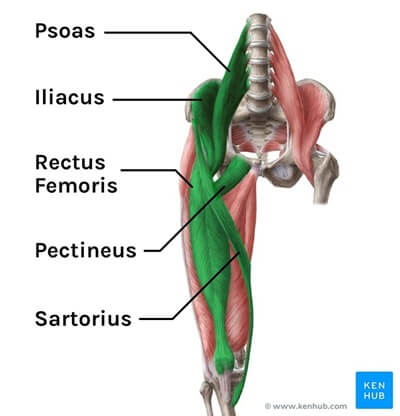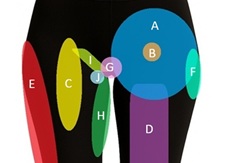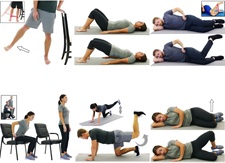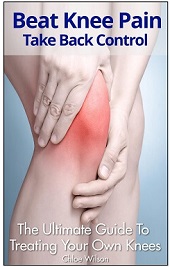- Home
- Hip Pain Diagnosis
- Hip Strain
Hip Flexor Strain
Written By: Chloe Wilson, BSc(Hons) Physiotherapy
Reviewed by: KPE Medical Review Board

A hip flexor strain is an injury to the muscles at the front of the hip.
It is a common source of hip and groin pain, particularly among athletes and physically active individuals.
Hip flexor strains can range from mild overstretching to complete muscle tears. They can cause upper thigh pain, weakness, stiffness, muscle spasms and reduced function.
In this article, we'll take a deep dive into everything you need to know about hip flexor strains, from anatomy and injury grades to diagnosis, treatment, recovery, and prevention.
What Is a Hip Flexor Strain?
A hip flexor strain is when there is overstretching or tearing of one or more of the hip flexor muscles. These muscles bend the thigh, lifting the leg towards the chest, and play a key role in walking, running, and kicking.

The main hip flexor muscles are:
- Iliopsoas (iliacus and psoas major): The strongest hip flexor and most commonly injured in strains
- Rectus Femoris: A quadriceps muscle that assists in hip flexion and knee extension
- Sartorius: The longest muscle in the body, crossing both the hip and knee to support movement
These muscles work together to perform actions like climbing stairs, sprinting, and bending at the hip. Any disruption in this muscle group can lead to pain and functional limitations. Hip flexor strains often occur during activities that involve sudden acceleration, kicking, or changes in direction.
A hip flexor strain may also be referred to as a pulled hip flexor, hip flexor tear or hip flexor injury. They are one of the most common causes of hip flexor pain.
Grades of Hip Flexor Tear
Hip flexor strains are classified into three grades, depending on the extent of the injury:
- Grade 1 (Mild): Minor stretching or microscopic tears. Symptoms include mild discomfort and slight stiffness, with minimal functional impact.
- Grade 2 (Moderate): Partial muscle tear, resulting in moderate pain, swelling, and difficulty walking or lifting the leg.
- Grade 3 (Severe): Complete rupture of the muscle fibers, often accompanied by severe pain, bruising, and loss of function. Surgical intervention may be needed.
Hip Flexor Strain Causes
Common causes of hip flexor strain injuries are:
- Sudden, explosive movements such as sprinting, jumping, kicking or rapid changes in direction
- Overuse from repetitive sports or training without proper recovery
- Inadequate warm-ups, leading to unprepared muscles
- Muscle fatigue, reducing strength and coordination, increasing injury risk
The hip flexors are particularly susceptible to tearing when they work from a stretched position or when they contract quickly against a force. Athletes in sports that involve repetitive stop and start movements, especially quick starts or pivoting movements e.g. soccer, football, hockey, martial arts, and dance are especially vulnerable to hip flexor strain injuries.
Risk Factors
Certain risk factors can make you more prone to hip flexor tears:
- Muscle imbalances between the hip flexors and extensors (glutes and hamstrings)
- Tight hip flexors that lack sufficient flexibility
- Previous hip or thigh injuries
Hip Flexor Strain Symptoms
Common symptoms of a pulled hip flexor muscle include:
- Sudden, sharp pain at the front of the hip or groin that gets worse when bending the hip
- Swelling, bruising, or tenderness in the upper thigh or hip
- Difficulty with daily activities e.g. walking, running or climbing stairs
- Muscle spasms or a pulling sensation during activity
- Weakness or stiffness in the hip, especially after resting or sitting
- A noticeable limp or inability to bear weight comfortably
- Pain At Night that stops you getting to sleep or wakes you up
Hip flexor pain is often localized to the front of the hip but may radiate into the upper thigh.
Diagnosing Hip Flexor
Injuries
Accurate diagnosis of hip flexor pain may involve both clinical evaluation and, in some cases, imaging:
- Patient History: Understanding when the pain started, what caused it, and how it behaves helps pinpoint the injury.
- Physical Exam: Your provider will check hip range of motion, tenderness, swelling, and strength.
- Functional Tests: Resisted hip flexion or straight leg raises may reproduce pain.
- Imaging: MRI or ultrasound may be ordered for moderate to severe strains to assess tissue damage and rule out more serious pathology.
Differential Diagnosis
There are a number of other conditions that can mimic hip flexor strain and cause hip flexor pain including:
- Hip labral tears
- Iliopsoas bursitis
- Hip Flexor Tendonitis
- Inguinal or sports hernias
- Groin strains (adductor muscles)
- Femoroacetabular impingement (FAI)
- Snapping Hip Syndrome
- Lumbar disc herniation or femoral nerve impingement
#CommissionsEarned from Amazon on qualifying purchases
Hip Flexor Strain Treatment
Most hip flexor strains can be managed conservatively without surgery. Early treatment focuses on pain control, while later phases aim to restore strength and mobility.
Acute Phase (First 48–72
hours)
- Rest: Avoid movements that cause pain or stress the injured muscle, and avoid stretching the muscle. If necessary, use crutches
- Ice Therapy: Apply ice packs for 15–20 minutes every 2–3 hours to reduce pain and inflammation
- Medication: pain-relieving medication such as paracetamol/acetaminophen can be taken regularly to reduce hip flexor pain. Avoid any anti-inflammatory medications e.g. ibuprofen/Advil for the first 2-4 days as they can actually slow down the healing process if taken too early
- Avoid Heat: initially as this increases inflammation and swelling
Rehabilitation Phase
Once the hip flexor pain subsides, rehab focuses on:
- Physical Therapy: A structured program to restore flexibility, strength, and functional movement
- Manual Therapy: Techniques like massage or myofascial release can help reduce tension and speed healing
- Progressive Loading: Controlled strengthening exercises are essential for long-term recovery
Hip Flexor Strain Exercises
Rehabilitation exercises for hip flexor strain recovery include:
- Strengthening Exs: hip strengthening exercises, quads strengthening and glute strengthening
- Stretching Exs: hip flexor stretches, quad stretches. Don’t start stretching exercises until isometric (static resisted) hip flexion is pain free
- Functional Training: Gradual return to sports-specific movements such as dynamic balance drills and sport-specific drills before return to play
Always progress hip flexor strain exercises gradually and stop any exercise that causes sharp pain.
Surgery For Hip Flexor Tear
Surgery is not usually necessary for a hip flexor strain unless there is a complete rupture or if the tendon has pulled away from the bone (avulsed).
Hip flexor tear surgery typically involves reattaching the injured tendon back onto the bone.
Pulled Hip Flexor Recovery
Recovery time for a hip flexor strain depends on the severity:
- Grade 1: 1 to 2 weeks with appropriate rest and rehab
- Grade 2: 3 to 6 weeks with structured rehab; physical therapy plays a key role
- Grade 3: 8-12 weeks or longer; surgery may be required in rare cases of complete rupture
Returning to sport should only happen once strength and flexibility are fully restored and pain-free movement is achieved else you risk ongoing hip flexor pain.
How To Prevent Hip
Flexor Injury
To reduce the risk of hip flexor tears, follow these prevention tips:
- Warm up properly before all activity
- Incorporate dynamic stretching for the hips and thighs
- Strengthen both hip flexors and extensors to maintain balance
- Core stability exercises to support hip mechanics
- Avoid overtraining and schedule regular rest days
- Use proper technique in sports and workouts
Hip Flexor Strain Summary
Hip flexor strains are common but manageable injuries that typically respond well to rest, physiotherapy, and a structured rehab program.
Pulled hip flexor injuries are usually caused by sudden over-stretching or repetitive overuse of the hip flexor muscles. They are particularly common in active individuals.
Common symptoms include pain in top of thigh that worsens with walking or lifting the leg, swelling, weakness and muscle spasms. It may also cause hip pain at night.
Most cases of hip flexor strains settle down within a few weeks with home treatments such as ice, rest, strengthening and stretching exercises.
You may also be interested in the following articles:
- Front Hip Pain
- Hip Flexor Pain
- Hip Flexor Tendonitis
- Hip Impingement Syndrome
- Hip Labral Tear
- Hip Bursitis
- Hip Muscle Anatomy
- Groin Strain
- Quads Tendonitis
Related Articles
Hip Pain At Night
October 2nd, 2025
Hip Pain Diagnosis
September 16, 2025
Hip Strengthening
September 24, 2025
Medical & Scientific References
- Epidemiology of Hip Flexor and Hip Adductor Strains in National Collegiate Athletic Association Athletes. The American Journal Of Sports Medicine
- Hip Flexor Strain - Aftercare. MedlinePlus
- The Influence of Stretching the Hip Flexor Muscles on Performance Parameters. A Systematic Review with Meta-Analysis. International Journal Of Environmental Research & Public Health
Last Updated: September 24th, 2025
Next Review Due: September 24th, 2027






